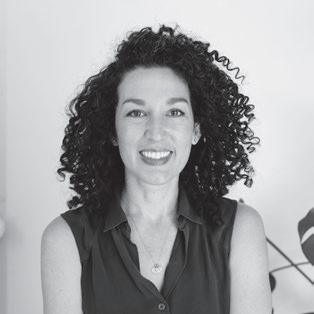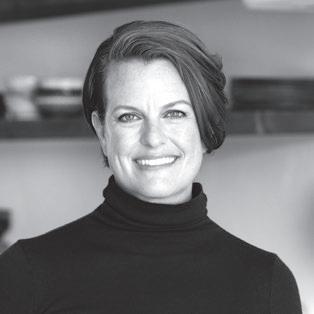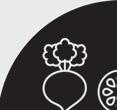‘Solid Starts helped me understand everything I needed to know when introducing solid food to my babies’ Hilary Swank
FOR BABIES
How to Introduce Solid Food & Raise a Happy Eater
‘Such a supportive guide for parents who are looking to explore baby-led weaning’ Charlotte Stirling-Reed
MORE PRAISE FOR SOLID STARTS FOR
BABIES
“As a parent and pediatric occupational therapist, Solid Starts for Babies is absolutely my go-to book for teaching baby to eat. It is inclusive, showcases cultural diversity, and reminds us of the bigger picture: how letting baby self-feed builds skill and resilience from the first bite.”
—Dr. Arameh Anvarizadeh, OTD, OTR/L, FAOTA, president-elect, American Occupational Therapy Association
“Solid Starts helped me understand everything I needed to know when introducing solid food to my babies. They guide you through everything from what foods to offer and how to prepare the food for each age to how to safely introduce food allergens. We didn’t make a move without it.”
—Hilary Swank, actress and twin mom
“An essential primer with everything you need to know as baby begins to explore real food.”
—Tina Payne Bryson, PhD, New York Times-bestselling co-author of The Whole-Brain Child
“As parents, we need ways to make mealtimes easier and Solid Starts gets it. With the app and now this book, Solid Starts is easy to use and full of practical guidance, actionable tips, and real-life strategies that every family needs as they introduce solid food to their babies.”
—Lindsey Laurain, founder of ezpz and mom of three
“Solid Starts has brought baby-led weaning to the mainstream. Their collective professional wisdom is at your fingertips with this comprehensive feeding guide, showing families that all babies can safely and intuitively feed themselves.”
—Jill Rabin, MS, CCC-SLP, IBCLC, Pediatric Speech & Language Pathologist, co-author of Your Baby Can Self-Feed Too
“As a psychiatrist who works closely with families, I’ve seen how early food experiences can shape a child’s relationship with eating throughout their life. I highly recommend Solid Starts for Babies to any parent looking for a gentle, intuitive way to nurture a positive connection to food from the very beginning.”
—Sarah Oreck, MD, MS, co-founder and CEO of Mavida Health
“Feeding my child turned out to be more stressful than I ever expected, and Solid Starts offers the most comprehensive, practical advice out there.”
—Myleik Teele, life coach and community curator
“Every new parent will benefit from this essential read. It provides clear guidance that supports both the baby and the family, paving the way for positive, enjoyable eating experiences and a healthy long-term relationship with food.”
—Sumner Brooks, MPH, RDN, co-author of How to Raise an Intuitive Eater
“Solid Starts for Babies offers evidence-based information on food allergies and allergen introduction in an easy-to-digest and reassuring format, helping families overcome fear and take action to reduce food allergy risk.”
—Ruchi Gupta, MD, MPH, professor of pediatrics at Northwestern University Feinberg School of Medicine and author of Food Without Fear
“Solid Starts for Babies is an invaluable resource for parents who want an evidence-based and balanced approach to introducing solids. The book’s expert insights into self-feeding bring a refreshing depth that’s hard to find in the crowded field of parenting advice.”
—Dr. Ashley Lerman, DDS
“A thorough, must-read guide for parents who want to nourish and nurture their baby’s health and happiness while they learn to eat.”
—Jill Castle, MS, RDN, founder of The Nourished Child and author of Kids Thrive at Every Size and Fearless Feeding
“Solid Starts for Babies guides parents in introducing a variety of foods, including commonly allergenic foods, with the goal of nurturing joyful eating habits and reducing the risk of food allergy.”
—Marion Groetch, MS, RD, associate professor at the Icahn School of Medicine at Mount Sinai and co-editor of Health Professional’s Guide to Nutrition Management of Food Allergies
“When parents ask me infant feeding questions, Solid Starts is always my first recommendation. With this book, I’m thrilled parents will find the information they need quickly and comprehensively from a team of pediatric professionals who truly care about the well-being of the whole family at mealtimes.”
—Mallory Whitmore, MEd, @theformulamom
“Solid Starts for Babies is the book every parent needs for learning to feed their babies to grow into independent and healthy eaters. This evidence-based guide walks parents through not just the practical steps of introducing foods, but also how to navigate common challenges when doing so. This is the new must-have book for parents and babies.”
—Dr. Sara Reardon, founder of @the.vagina.whisperer and mom of two
“This book leaves the reader in no doubt that giving babies a solid start in life is an investment in their future. In our modern, more fractured society, we must not forget the importance of human connection, especially within our family units. This very concept, where our tables and meals are central to our family connections, is at the core of this book.”
—Becca Maberly, founder of A Mother Place
SOLID STARTS FOR BABIES
SOLID STARTS FOR BABIES
How to Introduce Solid Food and Raise a Happy Eater
PENGUIN LIFE
UK | USA | Canada | Ireland | Australia India | New Zealand | South Africa
Penguin Life is part of the Penguin Random House group of companies whose addresses can be found at global.penguinrandomhouse.com
Penguin Random House UK , One Embassy Gardens, 8 Viaduct Gardens, London SW 11 7BW penguin.co.uk
First published in the United States of America by Crown 2025 First published in Great Britain by Penguin Life 2025 001
Copyright © Solid Starts, Inc., 2025
The moral right of the copyright holder has been asserted Illustrations by Carmen Deñó (chapter openers/spots), Lucy Anderson (infographics/charts), and Todd Detwiler (anatomical)
Penguin Random House values and supports copyright. Copyright fuels creativity, encourages diverse voices, promotes freedom of expression and supports a vibrant culture. Thank you for purchasing an authorized edition of this book and for respecting intellectual property laws by not reproducing, scanning or distributing any part of it by any means without permission. You are supporting authors and enabling Penguin Random House to continue to publish books for everyone. No part of this book may be used or reproduced in any manner for the purpose of training artificial intelligence technologies or systems. In accordance with Article 4(3) of the DSM Directive 2019/790, Penguin Random House expressly reserves this work from the text and data mining exception
Printed and bound in Great Britain by Clays Ltd, Elcograf S.p.A.
The authorized representative in the EEA is Penguin Random House Ireland, Morrison Chambers, 32 Nassau Street, Dublin D 02 YH 68
A CIP catalogue record for this book is available from the British Library
ISBN: 978–0–241–70996–2
Penguin Random House is committed to a sustainable future for our business, our readers and our planet. This book is made from Forest Stewardship Council® certified paper.
For those who have been pressured to eat or forced to finish their plate.
And for all the children to come.
May they find their love for food on their own terms.
About the Authors

Kary Rappaport
OTR/L, MS, SCFES, IBCLC Pediatric Feeding/Swallowing Specialist
Kary Rappaport is a licensed pediatric occupational therapist, certified feeding and swallowing specialist, and international board-certified lactation consultant based in Oregon.
For nearly twenty years, Kary has supported families with evaluation and treatment of feeding and swallowing challenges in infants and young children. She has extensive training and experience including administering modified barium swallow studies for this age group, managing complex feeding issues, and developing protocols and feeding programs. Kary has practiced as a pediatric occupational therapist in a variety of settings, including in-home, outpatient clinics, pediatric primary care offices, dental clinics, and leading medical institutions, including Children’s Hospital Los Angeles.
As a mom of two young children, Kary is a passionate advocate for clinical care that improves family access to connection-driven and researchsupported interventions with infant feeding, from birth to solid food to family meals. Throughout her career she has trained medical professionals and developed continuing education programs in infant feeding and swallowing in a wide range of clinical settings. In partnership with Kimberly Grenawitzke, she co-created professional courses on pediatric feeding which have influenced pediatric clinical care at numerous pediatric hospitals, university programs, and therapy clinics in the United States. Kary continues to teach and mentor fellow pediatric professionals through her leadership of Solid Starts PRO—an international network of medical professionals who are supporting parents with raising happy eaters.

Kimberly Grenawitzke
OTD, OTR/L, SCFES, IBCLC, CNT
Pediatric Feeding/Swallowing Specialist
Kimberly Grenawitzke is a licensed pediatric occupational therapist with specialty certification in feeding, eating, and swallowing; an international board-certified lactation consultant; and certified neonatal therapist based in Michigan.
Kim supports families with evaluation and treatment of feeding and swallowing challenges in infants and young children, including those with extreme prematurity, cancer/blood disorders, congenital heart disease, and other health conditions. For more than fifteen years, she has worked in both home settings and leading medical institutions, including Children’s Hospital Los Angeles and Lucile Packard Children’s Hospital Stanford. Kim earned her doctorate of occupational therapy from the University of Southern California.
As a mom of two young children, Kim is a passionate advocate for research and education that helps bridge the gap between pediatric healthcare and a family’s journey with infant feeding, from birth to solid food to family meals. She has created numerous continuing education opportunities to guide medical professionals, including the first doctoral residency program in occupational therapy at Children’s Hospital Los Angeles. In partnership with Kary Rappaport, she co-created professional courses on pediatric feeding for clinical training programs at Stanford University, the University of Southern California, California Children’s Services, and numerous pediatric therapy clinics in the United States. Their courses serve as the foundation for Solid Starts PRO and its pediatric community around the world.

Dr. Rachel Ruiz
MD, FAAP, CLC
Pediatrician and Pediatric Gastroenterologist
Dr. Rachel Ruiz is a board-certified pediatrician and pediatric gastroenterologist. She is based in California, where she serves as an attending pediatric gastroenterologist at Santa Clara Valley Medical Center and an affiliated clinical instructor of pediatric gastroenterology at Lucile Packard Children’s Hospital Stanford. Prior to her current roles, Dr. Ruiz completed her pediatric gastroenterology fellowship at Lucile Packard Children’s Hospital Stanford. She is also a fellow of the American Academy of Pediatrics, certified lactation counselor, and a member of the North American Society for Pediatric Gastroenterology, Hepatology & Nutrition. She earned her doctorate of medicine from Vanderbilt University School of Medicine, and subsequently completed her pediatric residency at Monroe Carell Jr. Children’s Hospital at Vanderbilt.









Dr. Sakina Bajowala
MD, FAAAAI
Pediatric Allergist/Immunologist
Dr. Sakina Bajowala is a board-certified allergist and immunologist and an internationally recognized expert in the treatment of life-threatening food allergies. Based in Illinois, she is the medical director of Kaneland Allergy & Asthma Center and executive director of the Kaneland Food Allergy Foundation. After earning her doctorate of medicine from Rush Medical College, she completed her pediatric residency at Comer Children’s Hospital of the University of Chicago and her allergy and clinical immunology fellowship at Rush University Medical Center. Dr. Bajowala is an active member of the American Academy of Allergy, Asthma, and Immunology; the American College of Allergy, Asthma, and Immunology; and the Illinois Society of Allergy, Asthma, and Immunology, of which she is currently serving as president.

Venus S. Kalami MNSP, RD, CSP
Pediatric Dietitian/Nutritionist
Venus Kalami is a registered dietitian and board-certified specialist in pediatric nutrition with specializations in digestive health and food allergy nutrition, based in California. With more than ten years of health experience, she has worked primarily at leading hospitals, including Stanford Medicine Children’s Health. Her expertise covers infant and toddler nutrition, general pediatrics, and children with medical complexities. She completed her dietitian training at Stanford Medicine and earned her master’s degree in nutrition science and policy from Tufts University. At Stanford Medicine Children’s Health, she established inaugural nutrition programs for the nationally recognized pediatric inflammatory bowel disease and celiac disease centers of excellence. She has published research on psychosocially informed nutrition, spoken nationally on cultural diversity in infant feeding, and led continuing education to thousands of health professionals.

Jenny Best Founder
Jenny is a mom of three on a quest to help families find joy at the table. Passionate about food and food culture, Jenny founded Solid Starts to make it easier for parents to learn how to introduce any food to their baby. Jenny is the creator of the award-winning First Foods® database, a searchable inventory of 400+ foods with step-by-step instructions, how-to videos, practical strategies, and recipes within the Solid Starts App.
Introduction
When my twins turned 6 months old, I held a chicken drumstick in front of each baby. They were panting for it, reaching for it. Their feet were kicking with excitement as each of them snatched one out of my hand and brought it right to their mouths. I stepped back, stunned. Could it really be this easy to get a baby to eat? This natural? I couldn’t believe my eyes. We had followed traditional recommendations and spoon-fed our first child, and the experience had been so different. As I watched the twins happily munch on their food—without needing any help from me—questions started to build . . . If letting a baby feed themself was so obviously natural, why weren’t more pediatricians talking about it?
—Jenny Best, founder, Solid Starts
The face of a baby who has been given a taste of something they find delicious is a beautiful thing to see. Equally hilarious are the expressions that pop up when they encounter a food that they find sour or bitter or just plain confusing. A few tastes later, you can see it dawn that they might actually like it. Or they will fling it onto the floor, which, from baby’s point of view, is a perfectly reasonable response.
Teaching a baby to eat solid food can be a slow and steady process. Set a pace that feels right for both you and baby. Babies need lots of time and practice to build the skills to eat real food, and together you will learn so much along the way. When should you begin? As you’ll learn, most babies can be offered real food around 6 months of
age, when they have the strength to sit upright, and the skills to coordinate the many movements needed for bringing food to the mouth and swallowing it. This developmental moment tips off an incredible window in baby’s life, a magical time when they are simultaneously eager to explore things with their mouth, easily interested in new foods, and have key physiological reflexes that help them learn how to chew. This magic window is a biological wonder of development, and by the end of this book, you’ll know everything you need to support baby as they learn how to feed themself.
Our approach is based on the idea that baby can eat the same food that you do. That giving baby the foods and flavors you enjoy from the start lays a strong foundation from which they can explore. This approach not only makes it possible to make one meal for everyone in the family, it also enables baby to learn by watching you eat the same food, which is exactly what their brain is set up to do.
Welcome to the Baby Food Revolution
Solid Starts was created with the idea that things could be different. We set out to challenge the status quo and change the conversation, and we are so happy to have you here with us, being curious, doing the research, asking big questions. Our mission has always been, and continues to be, to help parents raise children who love to eat and who listen to their bodies.
A wealth of new research shows there are tangible benefits for babies who are allowed to practice feeding themselves as soon as they are ready to start solids and that it’s safe to do so. However, much of the well-known literature is woefully outdated, and many health institutions and governmental bodies are late to the conversation. There is a popularized notion that babies need special baby food, when in fact it’s simply not true.
What if we were to tell you that baby food itself is a commercial invention? That, in reality, almost any food can be made safe for
babies? What if we were to tell you that many commercial baby foods don’t even contain the nutrients that babies need? Or that there’s no developmental necessity to start with a thin puree and graduate to a thicker mash? That much of what we as parents have been historically told about infant feeding are myths and fallacies?
What if we focused less on tricking baby to open their mouth for the spoon or how much puree baby swallows and more on the joy of eating? What if you had the knowledge to start solids more flexibly, in a way that works for your unique family? What if we trusted our babies to know when they are full? How might our babies benefit if we focused not on bites taken but on the child’s relationship with food?
If you want to raise a child who has a positive relationship with food, who trusts themself, who trusts you, and who eagerly tries new things, you’re in the right place. We want to give you the information you need to feel safe and confident to let baby eat enthusiastically on their own. When you give baby the space to explore and fumble, they develop skills that are highly transferable, helping them grow up to be more adaptable and independent—at the table and beyond.






The Solid Starts Team
Our team is composed of pediatric professionals: a boardcertified pediatrician and pediatric gastroenterologist, licensed feeding therapists and infant swallowing specialists, a boardcertified dietitian/nutritionist, and a board-certified allergist/ immunologist. We have deliberately created an integrative team, giving ourselves an opportunity to step out of our silos and create something useful that covers all of the bases for parents and professionals.
Our approach stems from the work of Gill Rapley, PhD who coined and defined the concept of baby-led weaning, and of
Kary Rappaport and Kim Grenawitzke, two occupational therapists with deep expertise in pediatric feeding and lactation who have worked to encourage infant self-feeding in various hospitals to help medically complex babies more quickly develop oral motor skills and form positive relationships with food.1 Together, Kim and Kary have become mentors to thousands of pediatric professionals around the world. They are truly the leading minds in infant feeding and possess deep expertise in food refusal at all ages. Their insight and wisdom is woven throughout every sentence in this book.
Our team also includes Dr. Rachel Ruiz, a double-boardcertified pediatrician and pediatric gastroenterologist and clinical instructor at Lucile Packard Children’s Hospital at Stanford, and she isn’t afraid to question the norms in medicine. Among the first pediatricians to publicly endorse the idea of letting babies feed themselves, Dr. Ruiz combs through research and often pokes holes in it. Together, we discovered a number of flaws in how the U.S. government collects data on choking and how the flawed data has been misinterpreted and reported over the years by various publications and media outlets, leading to a fear of choking that, quite simply, is out of proportion with the statistical likelihood of it occurring.
Our recommendations on allergens come from Dr. Sakina Bajowala, a leading physician in pediatric food allergy prevention and treatment and the author of her own book, The Food Allergy Fix. Whereas many healthcare providers are overrestricting foods to their patients, cutting them o from ever possibly tolerating those foods, Dr. B is an advocate for dietary diversity and is at the forefront of rapidly evolving treatments for food allergy, including sublingual and oral immunotherapies, which can help
individuals safely expand their diets, decrease the likelihood of allergic reactions, and improve their quality of life.
When it comes to nutrition, we take a real-life approach thanks to Venus Kalami, our board-certified pediatric dietitian and nutritionist with a passion for making infant self-feeding realistic and accessible for all. She has published in reputable journals and presented nationally on the importance of psychosocially informed, culturally sensitive, and weight-inclusive nutrition. Her goal is to help families trust themselves to nourish their baby’s (and their own) relationship with food and their body.
The inspiration for Solid Starts came from my lived experience, but our work today represents the team’s collective expertise and desire to help future families. —Jenny Best
The evidence for our approach is woven throughout this book. We have tried, diligently, to shine a light on existing literature, acknowledge where more research is needed, and highlight oftenoverlooked studies and findings. But the real proof is all around us. It’s in the parents who have chosen to let their babies feed themselves and who have watched their babies grow into toddlers who love to eat. It’s in the growing community of pediatric professionals who are empowering their patients to share the foods they love with their babies. And it’s in people like you who are taking the time to learn more and challenge the status quo.
We have served nearly 20 million parents in every single country of the world. Here are a couple of messages from them, which we share so that you might feel less alone:
“When my relationship with Solid Starts began, it took a long time, a lot of patience, a lot of listening to my child and his cues, but we’re making real progress. We have been going through recipes, trying new foods, having new experiences. He is really starting to enjoy food and it’s because of Solid Starts.”
“Solid Starts has completely revamped motherhood for me. It has been a major part of my healing process with post-partum depression and regaining a purpose with my baby . . . it gave me confidence and helped me take care of our son.”
“I was so scared to feed solid food to my daughter. I just had so much anxiety around wanting to make sure she has a healthy relationship with food as I definitely never have. Watching my daughter become confident with feeding herself and enjoying food just makes me overwhelmingly happy. I cannot thank you enough for making me feel comfortable and giving me the confidence to help teach my daughter how to eat and help her enjoy it as well.”
How to Use This Book
We wrote Solid Starts for Babies for parents, expecting parents, and caregivers, as well as pediatric professionals, to share the message that when baby is ready to begin the transition from breast or bottle to solid food, baby can enjoy almost any food with some basic safety modifications.
Keep in mind that we are never trying to prescribe specific foods for baby. We don’t want you to get in the habit of making special, separate meals for your children, now or later. In fact, quite the opposite. The best thing you can do is bring baby into your unique food culture right away.
In Part 1, Exploring Solids, you’ll get a run-through on why letting baby feed themself is an investment in the future, learn about the evidence, wonder at the myth of baby food, and marvel at nature’s wisdom and the biological underpinnings behind why we start solids around 6 months of age.
Part 2, Building Trust, explores the connection between mealtimes, our relationship with baby, and baby’s relationship with their own body. You’ll learn about responsive feeding, which takes into account baby’s engagement, and can help baby learn, grow, and work through new challenges. You’ll also learn all about baby’s biology, and the reflexes that help prevent choking as they learn to eat.
Part 3, Building Skill, gets right into it, from when to start to what equipment you need, before doing a deep dive into how to choose first foods and how to prep the food by age, prepare for the expected (and unexpected), and get baby involved with cups and other utensils.
Part 4, Building Resilience, gets into the basics of hunger and fullness cues, covers baby nutrition, and demystifies growth and weight charts. It also is of special importance, because research about when to start common allergens has evolved a great deal in the past years. Specifically, it is now understood that there are preventive benefits to introducing peanuts, milk, eggs, and more as soon as baby
is developmentally ready for solids (and in some cases, earlier). We’ve got you covered with clear guidance as to what, when, and how, including detailed allergen introduction schedules.
Part 5, Feeders and Growers, introduces you to various ways to engage baby, as well as offers insights into how they grow and learn at each stage, so you can learn to help them help themself.
And yes, there’s more, because when it comes to teaching baby to eat, there are always more questions, and we have answers. We will walk you through what to do about common mealtime challenges such as overstuffing, gagging, and food refusal to reflux.
We hear from so many parents who rely on scraps of information from various incomplete sources, much of it outdated and counterproductive. You deserve better and so do your kids. That’s why we built our app and wrote this book: to give you a thoughtful and useful resource that you can rely on again and again, from that first high chair moment to toddlerhood. Use the resources together. Download our app to access our award-winning First Foods database, and keep the book handy for a deeper dive.
We hope this book inspires you to find joy in sharing food with baby and helps you trust them at the table. Give baby space to explore, fumble, and learn. Trust that the foods you love to eat can be made safe for baby. Trust that baby knows when they are hungry or full. Trust that even if you feel nervous to start, with each day both you and baby will grow more confident. And on days when it feels like everything is falling apart, trust that you can always start fresh tomorrow.
As you read, please keep in mind that this book contains general feeding information that is informed by typical infant development.
The guidance we provide is geared toward children who are typically developing, healthy, and growing as expected by their medical team. Because all babies and families are unique, we expect that some of this information will not apply or will require modification. If your baby is following a different developmental pathway than expected, or if they have a disability or any medical needs, this information will likely need to be adapted. The guidelines found in this book can often be easily adapted to your unique child’s needs in collaboration with your child’s healthcare team.
For children with restricted diets or food allergies, suggested foods may be substituted for ones that are appropriate for baby. For example, a baby with a milk allergy could try a coconut-based yogurt in place of cow’s-milk yogurt. Children who have restricted diets, food allergies, and medical conditions that affect their growth and nutrition (such as cystic fibrosis, heart conditions, and digestive conditions) may need nutritional supplements, specialized formulas, and closer support with feeding and nutrition from pediatric specialists.
Many children with developmental delays, disabilities, sensory differences, or medical complexity will need more time and support to build a sense of comfort, safety, and skill with solid foods. If your baby has had any past negative experiences involving their face or
mouth (such as intubation, feeding tubes, or cleft lip/palate) or difficulty with breathing (needing any amount of oxygen support), they may need more patience and even more positive food experiences than usual before they gain confidence. Past history of food allergies, pain associated with eating, or even fear around food can all impact the pace of this transition and how much you can push baby when it comes to learning new skills at the table. Even when the stakes feel high, it is important to honor your child’s needs, autonomy, and willingness to engage in mealtimes. Every child has their own starting point and progresses on their own timeline. Use this book but also check in frequently with your healthcare team to be sure your child’s unique needs are being met. You can also check out Your Baby Can Self-Feed, Too: Adapted Baby-Led Weaning for Children with Developmental Delays or Other Feeding Challenges, an excellent resource to help guide you through adapting baby’s solid food journey as necessary.
Part One Exploring Solids
Chapter One
Choosing the Long Game
You sit down with your baby for dinner. You’re having a simple meal tonight, something that was easy to prepare, which you enjoy. You serve your baby the same food you serve yourself. There’s no pressure to eat anything. You happily focus on your meal, enjoying your food while baby smashes and explores theirs. You converse with your baby even though you’re not sure they understand you. Laughter fills the room. You are relaxed and calm. Everyone eats what they want, and leaves what they don’t, including baby, who pushes food off the table to let you know they are done. There’s food all over baby’s face, and you laugh about that, too.
Human beings are connection-driven creatures. There is a special feeling of ease and comfort when we are doing things alongside other
people we love. Mealtimes are just as much about personal connections as they are about the food. This is true for baby, too. Eating with you is a space for developing relationships as much as eating skills. The preceding anecdote isn’t really about dinner. It’s a story about relationships: the relationship between baby and their food, between baby and their body, and between you and baby. Every meal has potential to strengthen each of these connections.
It may sound obvious to say that love and trust are essential in all this, but sometimes what is most basic is what bears the most repeating. Parents and caregivers want to feed babies in the best way they can, but even the most attentive feeder can fall into the trap of focusing so deeply on the details of what to feed baby (or how much baby consumes) that they lose sight of the big picture—the joy of food and connection at the table.
When you make the table a place of connection, where everyone feels safe, cared for, and listened to, your child will want to keep coming back. They will feel seen and ready to learn. They will understand what it means to feel full in a way that is self-determined. Focusing on your relationship with your baby at the table is what we like to call the long game—where all of our micro decisions at meals build the future and the child’s long-term relationship with food, the table, and you.
The opposite of the long game is the short game: counting bites. Fretting over the number of milligrams of this or that your baby is eating. Distracting baby so they will open their mouth for one more spoonful. All of this detracts from what is important: creating a dynamic where baby is ready and wanting to learn how to eat.
Creating a Space for Connection
The first step in baby’s journey of learning to eat is interest. The key to getting baby interested and excited to explore food is their connection with the person who is eating with them.
As we will discuss in Chapter 4, connection is a basic human need. When baby is in connection with you, they want to be near you and watch you. When a baby is connected to a loving caregiver, they naturally imitate them and more easily learn from them. Babies have all the necessary tools to safely learn to eat, and in the majority of cases, these skills will naturally present themselves when baby has a strong relationship with a caregiver at the table.
Throughout this book we’ll give you examples of what it looks like to create a mealtime space where baby wants to be. We’ll help you understand what your role is and how to stay in connection with baby throughout this process. By the time you’re done reading, you’ll understand why so many people are choosing to let their babies selffeed, how it will benefit baby, when to start, what you’ll need—and how to implement these ideas starting on day one.
We’ll also get into all of the details—the gear, the foods, and how you prepare them—because details matter, but only if baby is ready and willing to be at the table.
It’s very hard to make a baby eat when they don’t want to. You can create the right conditions to interest them in a meal, but ultimately, a child must choose to eat. To do this, they need to choose to pick up a utensil or piece of food, open their mouth, and accept the food. Any attempt to get them to eat when they don’t want to will backfire, which research shows can negatively impact their relationship with food—and their relationship with you.1
Mealtimes happen multiple times a day, every day, making them a unique opportunity to establish and reinforce tangible skills like using a fork, chewing, and drinking from a straw, but also important intangible skills like handling disappointment, self-sufficiency, problem solving, and self-regulation. The adults at the table are learning too—to gradually let go and trust baby. Baby and caregiver are learning to trust each other.
This is why we begin our book here and will return to this idea of connection at the table. Everything else follows from there.
Investing in the Long Game Will Pay O
Teaching babies to eat solid food isn’t just about how much they eat in that moment; it’s about how you hope that the child will come to view food and meals in the weeks and years after. That’s the long game. For some, this hope might look like a child who enjoys eating, loves coming to the table with you, and has a positive relationship with food and their body. For others it might look like a child who is highly adaptable at meals, willing to try new foods and flavors. These are long-game goals.
The short game, in contrast, focuses on the here and now. It is heavily dependent on how your day is going. It’s more about what we need to do minute to minute to get through a certain moment than what we are working toward ultimately. In the ideal world, our shortgame choices would perfectly line up with and support our long-game aspirations, but more often than not, immediate needs get in the way.
For some, the short-game decisions might look like spoon-feeding baby to minimize the mess so they can get out the door on time. For others it might look like letting a toddler watch TV to keep the peace at dinner. Or only serving favorite snack foods to avoid tantrums. In a short-game moment—whatever that moment may be—by all means, do what you need to do. You can always try again.
If baby is approaching 6 months of age, now is a terrific time to consider your mealtime goals and start creating the patterns and practices that will get you there. If eating dinner together is something you want, start now. If you want baby to love foods that are culturally important to you, share those dishes early on. While it may seem easier to wait to start these things, a unique window in time is about to open, where baby is incredibly receptive to new foods and practices. In other words, it’s easier to teach baby this now than it will be later when they are a toddler.
After 12 months of age, many toddlers develop a natural resistance to trying new foods. This new phase is labeled “toddler neopho-
bia” by some researchers, because it appears to be a significant fear of trying new things, including foods. And after baby’s first birthday it is often harder—not easier—to teach a toddler how to chew foods and enjoy new flavors. Not only is it harder to teach a child to chew when they will not put the food in their mouth, but also key physiological reflexes that help babies easily learn these skills fade with age. Does that mean the child who starts late will never learn? Of course not. But when it comes to food, it’s simply easier to teach many of these skills when a baby is younger. Is it a guarantee that your toddler will eat everything they were served as a baby? Unfortunately, no. But the research is clear: the more exposure a baby gets to a wide variety of foods, the more likely it is they will continue to eat them (or eventually come back to them) in toddlerhood and beyond.2,3,4
To build new skills, babies need lots of time and space for repetitive practice. The same goes for eating. The more you spoon-feed a baby, the longer it will take for them to learn how to feed themself. Similarly, the more you rely on commercially designated baby foods, the longer it will take that child to accept the foods the rest of the family is eating. Yes, pouches and puffs can have a role to play in the short game. Please, use them when you need them. Just keep the long game in mind.
When we prioritize the long game and let babies fumble their way through, we provide children with important learning opportunities. On a macro scale, we want baby to learn that they are capable of learning new things and handling challenges. On a micro scale, we want baby to learn basic skills like self-feeding and chewing thoroughly. The more you get out of the way and let baby practice by trial and error, the faster they will learn—and that’s a long game that benefits parents and children alike.
Choosing Joy
Our approach is designed to help you foster a child’s inherent motivation around food. With this in mind, we invite you to let go of any
feeding rules and requirements that may have been passed down to you. Let go of any desire to achieve perfection. Skip suggestions that do not seem to fit your baby’s or family’s needs. Release rigidity to make space for something much more important: joy. There is no perfect meal. There is no perfect food. There is no perfect high chair, plate, or utensil. But there is an ideal environment to learn. And that’s a joyful one.
If you want to support baby’s journey toward becoming a child who listens to their body and trusts their hunger and fullness cues, who feels at ease around food, and who loves eating with you, make the table a place they want to be. Focus on connection, on sharing the foods you love, and trusting that baby can do it. The rest will naturally follow.
Summary
✓ Babies learn best when they feel connected to (and trust) their caregiver.
✓ Babies learn to eat by watching you eat the same food.
✓ Consider your mealtime goals and hopes for your child and how you want to get there.
✓ Baby is most receptive to new foods and practices before 12 months of age.
✓ After their first birthday, many toddlers develop a resistance to trying new foods.
✓ When you make the table a place of connection, your child will want to come back.
Chapter Two Evolving with the Evidence
The wet-nurse may take a moderate quantity of sound porter, or of mild (but not old or strong) ale, with her dinner. Tea should be taken at half-past five or six o’clock; supper at nine, which should consist of a slice or two of cold meat, or of cheese if she prefer it, with half a pint of porter or mild ale: occasionally, a basin of gruel may be substituted, with advantage. Hot and late suppers are, prejudicial to the mother, or wet-nurse, and, consequently, to the child. The wet-nurse must be in bed every night by ten o’clock.
Advice to a Young Mother on the Management of Her Children by Pye Henry Chavasse, 1865
Advice on how to care for babies can come with some very loud voices and some very strong opinions. With every generation, many of those ideas (thankfully) change. At Solid Starts, we believe in following the evidence, and, where evidence is lacking, to lean on the science of physiology and child development. Let’s take a look back to see what people used to think, why things changed, and how we arrived from the myths of the past to the science-backed practices we recommend in these pages.
We begin our tour in the 1800s. You’re a new mother, and for the first year of baby’s life, all they will get is breast milk, with wet nurses’ help to make this possible. Solid food won’t be offered until baby is around a year old.
Fast forward to the 1950s, when the popular magazines of the day are full of images of jolly infants being spoon-fed from little glass jars. When your doctor tells you that your 1-month-old infant is ready to start commercial baby food, you do what they suggest. After all, the food is made by men in white coats, “scientifically” concocted.
Now jump to the 1980s. You see an ad in a magazine suggesting that your breast milk may not be enough, and that you should supplement with commercial baby food. At the same time, you are advised to start solids around 4 months of age but to avoid serving baby allergens like egg and peanut until they are 3 years old.
And now here we are in the mid-2020s, in an era when pediatric authorities generally agree that the optimal time to introduce solids is around 6 months of age or when a baby shows developmental readiness. And because we saw allergies in the pediatric population surge alongside the old recommendations, doctors today (should) know that we need to introduce common allergens like egg and peanut right away when starting solids, if not earlier.
Over the years, as medical professionals have learned more about infant nutrition, allergy, immunology, and child development, how and when we introduce solid food to babies has drastically changed.
Alongside these changes in the medical community, we’ve seen a shift in how we choose to parent and interact with children. So if you find yourself in disagreement with your parents, grandparents, or inlaws about how to feed baby, you’re not alone. You may even get differing opinions from different doctors and health professionals. Research has rapidly evolved and it’s difficult to keep up.
Age of Introducing Solids Over Time
Building on research by New York University professor Amy Bentley, this line graph demonstrates how the age of introduction of solid food has varied widely over time. In instances of wide variation, such as the 1950s and 1960s, the lowest commonly recommended age was plotted. Research and pediatrics have advanced since the late nineteenth century. Today most leading pediatric authorities agree: around 6 months of age is ideal for introducing solid food.
Today’s evidence shows us that when babies are exposed to a wide variety of colorful foods, tastes, and textures—before 12 months of age—they are more likely to be open to exploring new foods later
